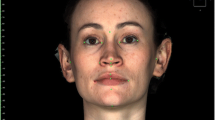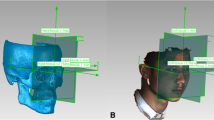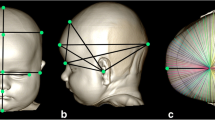Abstract
The aim of this work was to estimate the accuracy of craniofacial reconstruction (CFR), from a series of 25 controlled cases. Three protocols of blind CFRs (exhibiting an increasing complexity from A to C) were assessed in this paper, allowing comparison of the CFR with the actual face of the deceased. The whole results showed that an excellent, or good, to middle resemblance (between the blind CFR and the actual face of the subject) was reached in 9 out of 25 cases, but the success gradually increased from the A to the C protocol of CFR, reaching six cases out of eight in the latter. Statistical comparison of measurements (between the blind CFR and the actual face) was also achieved, revealing that some anthropological distances were constantly underestimated or overestimated. This experiment shows that a thorough anthropological, odontological, and X-ray analysis is indispensable before performing a CFR, and these encouraging results justify further efforts of research in this field.
Similar content being viewed by others
References
Olze A, Bilang D, Schmidt S, Wernecke KD, Geserick G, Schmeling A (2005) Validation of common classification systems for assessing the mineralization of third molars. Int J Legal Med 119:22–26
Muhler M, Schulz R, Schmidt S, Schmeling A, Reisinger W (2006) The influence of slice thickness on assessment of clavicle ossification in forensic age diagnostics. Int J Legal Med 120:15–17
Schmeling A, Schulz R, Danner B, Rosing FW (2006) The impact of economic progress and modernization in medicine on the ossification of hand and wrist. Int J Legal Med 120:121–126
Schmeling A, Baumann U, Wernecke KD, Reisinger W (2006) Reference data for the Thiemann-Nitz method of assessing skeletal age for the purpose of forensic age estimation. Int J Legal Med 120:1–4
Schulz R, Muhler M, Mutze S, Schmidt S, Reisinger W, Schmeling A (2005) Studies on the time frame for ossification of the medial epiphysis of the clavicle as revealed by CT scans. Int J Legal Med 119:142–145
Quatrehomme G, Cotin S, Alunni V, Garidel Y, Grévin G, Bailet P, Ollier A, Ayache N (1999) La superposition, la restauration et la reconstruction faciales: une aide à l’identification médico-légale. Journal de Médecine Légale Droit Médical 42:11–22
Quatrehomme G, Subsol G (2005) Classical non-computer-assisted craniofacial reconstruction. In: Clement JG, Marks MK (eds) Computer graphic facial recontruction. Elsevier, Academic, Amsterdam, pp 15–32
Aulsebrook WA, Becker PJ, İşcan MY (1996) Facial soft-tissue thicknesses in the adult male Zulu. Forensic Sci Int 79:83–102
De Greef S, Willems G (2005) Three-dimensional cranio-facial reconstruction in forensic identification: latest progress and new tendencies in the 21st century. J Forensic Sci 50:12–17
Quatrehomme G, İşcan MY (2000) Computerized facial reconstruction. In: Siegel JA, Saukko PJ, Knupfer GC (eds) Encyclopedia of forensic sciences. Academic, San Diego, pp 773–779
Pötsch L, Herz U, Leithoff H, Urban R, Rittner Ch (1994) Zur postmortalen Gesichtsrekonstruktion. Arbeitskonzept einer schnellen Identifizierungsmöglichkeit. Rechtsmedizin 4:61–68
Moss JP, Linney AD, Grindrod SR, Arridge SR, Clifton JS (1987) Three-dimensional visualization of the face and skull using computerized tomography and laser scanning techniques. Eur J Orthod 9:247–253
Quatrehomme G, Cotin S, Subsol G, Delingette H, Garidel Y, Grévin G, Fridrich M, Bailet P, Ollier A (1997) A fully three-dimensional method for facial reconstruction based on deformable models. J Forensic Sci 42:647–650
Yoshino M, Matsuda H, Kubota S, Imaizumi K, Miyasaka S (2000) Computer-assisted facial image identification system using a 3-D physiognomic range finder. Forensic Sci Int 109:225–237
Nelson LA, Michael SD (1998) The application of volume deformation to three-dimensional facial reconstruction: a comparison with previous techniques. Forensic Sci Int 94:167–181
Miyasaka S, Yoshino M, Imaizumi K, Seta S (1995) The computer-aided facial reconstruction system. Forensic Sci Int 74:155–165
Evenhouse R, Rasmussen M, Sadler L (1992) Computer-aided forensic facial reconstruction. J Biocommun 19:22–28
Vanezis P, Vanezis M, McCombe T, Niblett T (2000) Facial reconstruction using 3-D computer graphics. Forensic Sci Int 108:81–95
Subsol G, Quatrehomme G (2005) Automatic 3D facial reconstruction by featured-based registration of a reference head. In: Clement JG, Marks MK (eds) Computer graphic facial recontruction. Elsevier, Academic, Amsterdam, pp 79–101
Clement JG, Marks MK (2005) Computer graphic facial recontruction. Elsevier, Academic, Amsterdam
Vandermeulen D, Claes P, Loeckx D, De Greef S, Willems G, Suetens P (2006) Computerized craniofacial reconstruction using CT-derived implicit surface representations. Forensic Sci Int 159(Suppl 1):164–174
Snow CC, Gatliff BP, McWilliams KR (1970) Reconstruction of facial features from the skull: an evaluation of its usefulness in forensic anthropology. Am J Phys Anrthropol 33:221–228
Gatliff BP, Snow CC (1979) From skull to visage. J Biocommun 6:27–30
Stewart TD (1954) Evaluation of evidence from the skeleton. In: Gradwohl RBH (ed) Legal medicine. Mosby, St. Louis
Stephan CN (2003) Anthropological facial reconstruction-recognizing the fallacies, ‘unembracing’ the errors, and realizing method limits. Sci Justice 43:193–200
Angle EH, Die Okklusionsanomalien der Zähne, 2, Aufl. Meusser, Berlin. Cited by Rakosi Th and Irmtrud J, Atlas de Médecine Dentaire. Orthopédie dentofaciale, Diagnostic, Paris, Médecine Sciences Flammarion, p. 46
Moore CE (1981) A problem in human variation: the facial tissue thicknesses of Caucasoids, Negroids, and Mongoloids. Ph.D. Dissertation. The University of New Mexico, Albuquerque, New Mexico
Rhine JS, Moore CE, Weston JT (eds) (1982) Facial reproduction : tables of facial tissue thicknesses of American Caucasoids in forensic anthropology. Maxwell Museum Technical Series1, Albuquerque, New Mexico
Krogman WM, İşcan MY (1986) The human skeleton in forensic medicine. Charles C Thomas, Springfield, Ill
Macho GA (1986) An appraisal of plastic reconstruction of the external nose. J Forensic Sci 31:1391–1403
Quatrehomme G (2000) Reconstruction faciale: intérêt anthropologique et médico-légal. Ph.D., University of Bordeaux I (France), Faculty of Sciences
Yoshino M, Seta S (2000) Skull-photo superimposition. In: Siegel JA, Saukko PJ, Knupfer GC (eds) Encyclopedia of forensic sciences. Academic, San Diego, pp 807–815
Aulsebrook WA (2000) Facial tissue thickness in facial reconstruction. In: Siegel JA, Saukko PJ, Knupfer GC (eds) Encyclopedia of forensic sciences. Academic Press, San Diego, pp 779–788
Rogers SL (1987) Personal identification from human remains. Charles C Thomas, Springfield, Ill
George RM (1987) The lateral craniographic method of facial reconstruction. J Forensic Sci 32:1305–1330
Quatrehomme G, Garidel Y, Grévin G, Liao ZG, Bailet P, Ollier A (1995) Method for identifying putrefied corpses by facial casting. Forensic Sci Int 74:115–124
Quatrehomme G, Garidel Y, Grévin G, Liao ZG, Bailet P, Boublenza A, Ollier A (1996) Facial casting as a method to help identify severely disfigured corpses. J Forensic Sci 41:518–520
Rakosi T (1982) An atlas and manual of cephalometric radiography. Wolfe Medical Publications, London
Aulsebrook WA, İşcan MY, Slabbert JH, Becker P (1995) Superimposition and reconstruction in forensic facial identification: a survey. Forensic Sci Int 75:101–120
Fedosyutkin BA, Nainys JV (1993) The relationship of skull morphology to facial features. In: İşcan MY, Helmer RP (eds) Forensic analysis of the skull. Wiley-Liss, New York, pp 199–213
Puech PF (1995) Portrait of the ‘Temple Child’, a missing-link in the case of Louis XVII. Int J Legal Med 107:209–212
Hill B, McLeod I, Crothers A (1996) Rebuilding the face of George Buchanan (1506–1582). J Audiov Media Med 19:11–15
Gerasimov MM (1949) Principles of reconstruction of the face on the skull. Moscow, Nauka [in Russian language]. Quoted by: Fedosyutkin BA, Nainys JV. The relationship of skull morphology to facial features. In: İşcan MY, Helmer RP (eds) Forensic analysis of the skull. Wiley-Liss, New York, pp 199–213
Gerasimov MM (1955) Reconstruction of the face on the skull. Moscow, Nauka [in Russian language]. Quoted by: Fedosyutkin BA, Nainys JV. The relationship of skull morphology to facial features. In: İşcan MY, Helmer RP (eds) Forensic analysis of the skull. Wiley-Liss, New York, pp 199–213
Gerasimov MM (1971) The face finder. Lippincott, Philadelphia
Vanezis P, Blowes RW, Linney AD, Tan AC, Richards R, Neave R (1989) Application of 3-D computer graphics for facial reconstruction and comparison with sculpting techniques. Forensic Sci Int 42:69–84
Vanezis M, Vanezis P (2000) Cranio-facial reconstruction in forensic identification-historical development and a review of current practice. Med Sci Law 40:197–205
Shahrom AW, Vanezis P, Chapman RC, Gonzales A, Blenkinsop C, Rossi ML (1996) Techniques in facial identification: computer-aided facial reconstruction using a laser scanner and video superimposition. Int J Legal Med 108:194–200
Claes P, Vandermeulen D, De Greef S, Willems G, Suetens P (2006) Craniofacial reconstruction using a combined statistical model of face shape and soft tissue depths: methodology and validation. Forensic Sci Int 159 (Suppl 1):147–158
Krogman WM (1946) The reconstruction of the living head from the skull. FBI Law Enforc Bull 15:11–18
Ilan E (1964) Identifying skeletal remains. Int Crim Police 175:42–45
Suzuki T (1973) Reconstruction of a skull. Int Crim Police Rev 264:76–80
Rathbun TA (1984) Personal identification: facial reproductions. In: Rathbun TA, Buikstra JE (eds) Human identification: case studies in forensic anthropology. Charles C Thomas, Springfield, Ill, pp 347–356
Gerasimov MM (1968) Ich suchte Gesichter. C. Bertelsmann, Gütersloh. Quoted by: Helmer RP, Röhricht S, Petersen D, Möhr F. In: İşcan MY, Helmer RP (eds) Forensic analysis of the skull. Wiley-Liss, New York, pp 229–246
Stephan CN (2002) Do resemblance ratings measure the accuracy of facial approximations? J Forensic Sci 47:239–243
Stephan CN, Arthur RS (2006) Assessing facial approximation accuracy: how do resemblance ratings of disparate faces compare to recognition tests? Forensic Sci Int 159 (Suppl 1):159–163
Stephan CN, Henneberg M (2001) Building faces from dry skulls: are they recognized above chance rates? J Forensic Sci 46:432–440
Suk V (1935) Fallacies on anthropological identifications and reconstructions. A critique based on anatomical dissections, vol. 207. Publications of the Faculty of Science University of Masaryk, Prague pp 1–18
Brues AM (1958) Identification of skeletal remains. J Crim Law Criminol Police Sci 48:551–563
Kerley ER (1977) Forensic anthropology in forensic medicine. In: Tedeschi CD, Eckert WG, Tedeschi LG (eds) Physical Trauma, Vol. II. WB Saunders, Philadelphia, pp. 1101–1115
George RM (1993) Anatomical and artistic guidelines for forensic facial reconstruction. In: İşcan MY, Helmer RP (eds) Forensic analysis of the skull. Wiley-Liss, New York, pp 215–227
Haglund WD (1998) Forensic “art” in human identification. In: Clement JG, Ranson DL (eds) Craniofacial identification in forensic medicine. Arnold, London, pp 235–243
Haglund WD, Reay DT (1991) Use of facial approximation techniques in identification of Green River serial murder victims. Am J Forensic Med Pathol 12:132–142
Stephan CN, Henneberg M (2006) Recognition by forensic facial approximation: case specific examples and empirical tests. Forensic Sci Int 156:182–191
Helmer RP, Röhricht S, Petersen D, Möhr F (1993) Assessment of the reliability of facial reconstruction. In: İşcan MY, Helmer RP (eds) Forensic analysis of the skull. Wiley-Liss, New York, pp 229–246
Rhine JS, Campbell HR (1980) Thickness of facial tissues in American blacks. J Forensic Sci 25:847–858
Domaracki M, Stephan CN (2006) Facial soft tissue thicknesses in Australian adult cadavers. J Forensic Sci 51:5–10
Phillips VM, Smuts NA (1996) Facial reconstruction: utilization of computerized tomography to measure facial tissue thickness in a mixed racial population. Forensic Sci Int 83:51–59
De Greef S, Claes P, Mollemans W, Loubele M, Vandermeulen D, Suetens P, Willems G (2005) Semi-automated ultrasound facial soft tissue depth registration: method and validation. J Forensic Sci 50:1282–1288
De Greef S, Claes P, Vandermeulen D, Mollemans W, Suetens P, Willems G (2006) Large-scale in-vivo Caucasian facial soft tissue thickness database for craniofacial reconstruction. Forensic Sci Int 159(Suppl 1):126–146
El-Mehallawi IH, Soliman EM (2001) Ultrasonic assessment of facial soft tissue thicknesses in adult Egyptians. Forensic Sci Int 117:99–107
Utsuno H, Kageyama T, Deguchi T, Yoshino M, Miyazawa H, Inoue K (2005) Facial soft tissue thickness in Japanese female children. Forensic Sci Int 152:101–107
Simpson E, Henneberg M (2002) Variation in soft-tissue thicknesses on the human face and their relation to craniometric dimensions. Am J Phys Anthropol 118:121–133
Ellis HD (1981) Theoretical aspects of face recognition. In: Davies G, Ellis HD, Shepherd J (eds) Perceiving and remembering faces. Academic, London, pp 171–197
Author information
Authors and Affiliations
Corresponding author
Rights and permissions
About this article
Cite this article
Quatrehomme, G., Balaguer, T., Staccini, P. et al. Assessment of the accuracy of three-dimensional manual craniofacial reconstruction: a series of 25 controlled cases. Int J Legal Med 121, 469–475 (2007). https://doi.org/10.1007/s00414-007-0197-z
Received:
Accepted:
Published:
Issue Date:
DOI: https://doi.org/10.1007/s00414-007-0197-z




